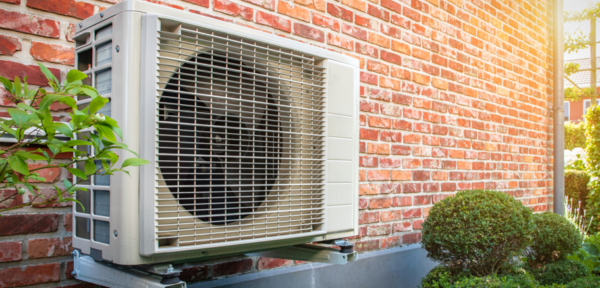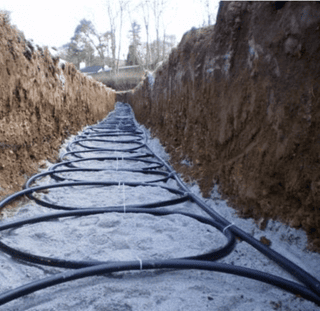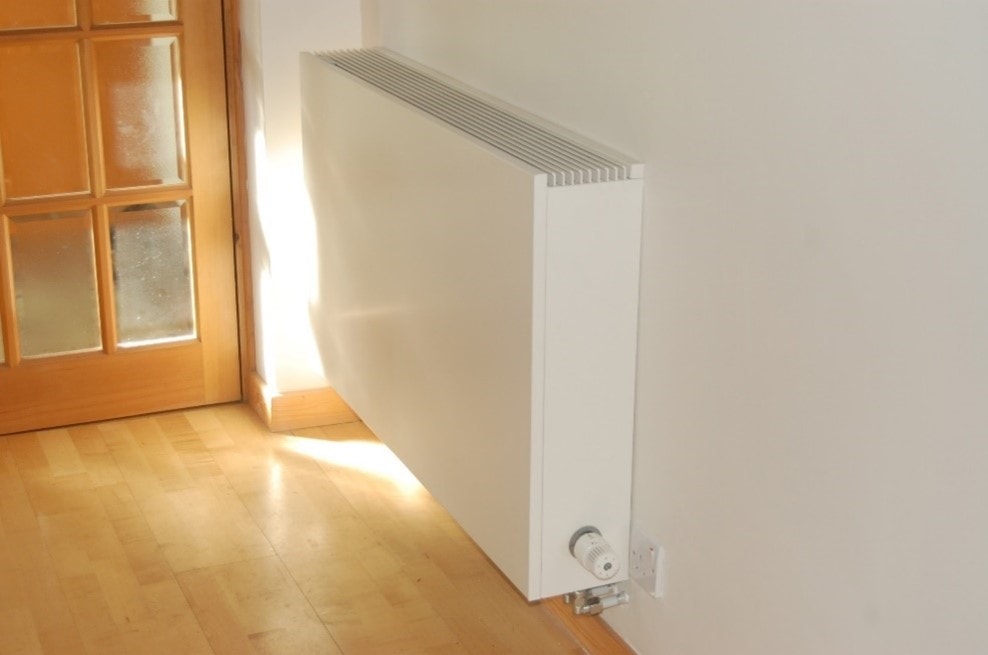Heat Pumps – The Future for Home Heating.

In September 2020, the NHBC Foundation published a guide called “The Future for Home Heating – life without fossil fuels” [ref. NF87], which was researched and written by Dr Neil Cutland, then of Cutland Consulting Ltd. but now the Consultancy Director at Sava.
The guide was produced following the publication of the government’s “Future Homes Standard” in 2019, which stated the intention that new homes will not be permitted to be connected to the gas grid from 2025 onwards. It considers what the non-gas home of 2025 might look like.
This article, written by Dr Neil Cutland, looks specifically at heat pumps as an alternative to gas central heating and the challenges we face if we are to replace gas boilers with electric heat pumps.
Introduction
In June 2022, Part L (conservation of heat and power) and Part F (ventilation) of the Building Regulations changed, meaning that carbon emissions in homes built to the new regulations will be 31% lower than the previous (2013) regulations. From 2025, when no new homes will be connected to the gas grid, the carbon emissions should be around 75-80% lower than the 2013 regulations. Efficiencies of heat pumps can exceed 300%, and government policies focus heavily on heat pumps as an alternative to gas central heating. The government’s Heat and Building Strategy states:
“Heat pumps are already a predominant technology in some other countries, and have high levels of customer satisfaction; however, work needs to be done to build UK supply chains and drive down costs.”
The UK is clearly not leading the way with this technology. For example, Finland, a country with approximately 3 million households, has witnessed a move away from fossil fuels (they do use electricity, but 46.2 % of electricity generation in Finland comes from renewables [Statistics Finland, 2019]) and it has been estimated that 1,030,000 heat pumps have been sold since the year 2000. (Source)
What is a typical low-energy home?
Before looking at heat pumps in detail, we need to understand what a low-energy home looks like and why it is relevant when considering carbon emissions.
In theory, the carbon emissions of a dwelling could be reduced solely by switching to low-carbon technologies for heating and lighting. However, the given thinking is that a ‘fabric first’ approach to the design of the building, to maximise the performance of the materials of the building fabric itself, should be implemented before considering the use of alternative building services.
A ‘typical’ low-energy home is likely to have the following characteristics:
- minimal space heating demand (e.g. floor, roof and wall U-values around
0.10 – 0.15 W/m2K; triple-glazed windows; near-zero thermal bridges – which in practice means psi-values ≤ 0.01W/mK; air leakage ≤ 1.0m3/m2h @50Pa) - mechanical ventilation with heat recovery (MVHR) with an efficiency of 85% or better
- good heating controls (ideally zoned and weather-compensated)
- LED fixed lighting
- efficient electrical appliances (A+ or better), if provided by the builder.
- To make this low-energy home a low-carbon home, a low-carbon heating and hot water system (such as a heat pump) must also be installed.
How does a heat pump work?
Heat pumps work by transferring thermal energy from outside (taken from the air or the ground) so that it can be used inside and distributed via emitters. There is heat available to be taken from outside in winter as well as summer.
A compressor (run by electricity) pumps a fluid around the loop. As it pumps through the compressor, it becomes hot and goes through a distribution system inside the house, where it gives up much of its heat. It is then cooled down further through an expansion valve, is pushed outside the building and through another heat exchanger where it picks up heat from outside and goes around the circuit again.

Figure 1: Diagram showing basic principles of how a heat pump works. Source: Energy Saving Trust
Fundamentally, there are two types of heat pump: air source heat pumps (ASHPs) and ground source heat pumps (GSHPs).
Air source heat pumps transfer heat from the outside air into the heat pump’s fluid by using a fan, and then pumps it into the house. The image below shows a typical outside unit of an air source heat pump.

Figure 2: Air source heat pump unit
Ground source heat pumps collect heat from the ground. A separate fluid is pumped through a buried pipework loop and picks up the heat. There are two types of loop: a vertical loop in a borehole, and a horizontal loop laid in a shallow trench. (You may have heard of closed loop and open loop. It’s rare to find open loops in homes – they are usually found in larger, mixed developments like holiday complexes where there is a stream or lake available as the heat source.)
A vertical bore can be expensive, but the bore can extend metres down into the ground where there is more heat. These are required for dwellings that do not have much ground.
Horizontal loops can be laid as a single loop around the perimeter of the available ground, or as coiled loops (informally called slinkies) where the perimeter of the ground is insufficient for a single loop.

Figure 3: Slinky horizontal loop in a shallow trench. Source: Kensa Heat Pumps
In the UK, the temperature at just 1 metre below the ground tends to remain at around 10-12°C regardless of the time of year. This is ideal for heat pumps, which prefer the source temperature to be consistent. However, with air source heat pumps, the temperature of the outside air can vary greatly depending on the time of the year.
There is yet another form of heat pump technology–a water source heat pump (WSHP)–which works in a similar way to air or ground source heat pumps and uses the heat energy from water to provide heating and hot water.
There are two main WSHP designs: a closed loop system or an open loop system. Closed loop systems are used in lakes, lochs, or large ponds. Open loop systems are used with boreholes near rivers or other areas where the geological conditions are suitable.
Water source heat pumps are very niche in a domestic setting since comparatively few dwellings have access to a suitable water source and no normal developer would consider them. However, there is the potential opportunity for community-based WSHPs or for use in mixed developments such as holiday complexes. In 2014, the Government Department for Energy and Climate Change (DECC) introduced a water source heat map of England (see here).
The map was developed for local authorities, community groups and private developers, in order to highlight the opportunities for deploying innovative heat pump technology in the nation’s rivers and water sources to produce energy from a low-carbon, cheap and reliable source. However, this map just identifies potential opportunities. There would be many legal and practical factors to consider if the potential were to be harnessed.
Once the heat has been captured from the ground or air and passed through the heat pump’s compressor, it needs to be distributed around the dwelling. This can be via the air or a wet circuit with radiators and/or underfloor heating.
Underfloor heating is ideal for heat pumps, as it requires a fairly low temperature compared to radiators (you wouldn’t want to walk on floor as hot as a radiator), and the output temperature of a heat pump is well matched to this. It is common to mix underfloor heating downstairs with radiators upstairs. However, underfloor heating is expensive to retrofit into existing properties.
When installing heat pumps, it’s strongly recommended that a qualified MCS-accredited heating system designer who specialises in heat pumps is consulted. If the heat pump and/or emitters are not correctly sized (i.e. are neither undersized nor oversized) then the property may not heat properly, risking excessive running costs, the heat pump breaking down, a cold house and very unhappy occupants. This will be outside the remit of most surveyors’ reports, so if inspecting a property with a heat pump, you should advise your client to check with the vendor or installer who specified the system and if necessary, get a qualified heating designer to check the specification.
Suggested wording for a level 2 inspection and report:
“The property is heated by a ground/air (delete as necessary) source heat pump. Such installations must be designed and installed by qualified heating system specialists to ensure that the heat pump and emitters (fan units / radiators / underfloor pipework) are correctly sized, otherwise the temperature in the property may not be sufficient (especially in colder weather). Your legal adviser should request the vendor to provide documentation detailing the system and its specification.
You are strongly advised to instruct an MCS accredited specialist heat pump engineer to inspect the system to ensure that it is operating correctly and that both the heat pump and the emitters are of the correct size, prior to entering into a legal commitment to purchase the property.”
Emitter sizing
Heat pump flow temperatures are lower than those of conventional central heating boilers. Although it won’t feel like it when you touch a radiator, the water that comes from the gas boiler that feeds the radiator will be around 65-70°C. Although it has cooled down slightly by the time it reaches the radiator, it can still cause burns. However, a heat pump output temperature will be typically 45-55°C, so to get the air temperature inside the home up to a comfortable temperature, the radiators need to be physically larger.
There are now alternative low-temperature radiators, usually made of a less dense metal like aluminium and which may have highly efficient convection fins behind them, low water content, and possibly even a small fan that pushes the heat out more effectively. They are usually slightly deeper than a common radiator but otherwise are similar in area. They are more expensive than ordinary radiators.

Figure 4: Example of a radiator used with a heat pump. Source: Jaga UK
Domestic hot water
Domestic hot water can be challenging with heat pumps because water needs to be heated to 60°C or more to avoid legionella risk. Heat pumps generally work at lower temperatures than this – so how do you heat hot water with a heat pump adequately? There are several ways.
The heat pump output temperature can be boosted temporarily while heating the water. This is a common solution, although, heat pumps operate at much lower efficiencies while this happens, so it could be an expensive option.
Some systems will allow the heat pump to run at its normal temperature and then boost the hot water temperature using an immersion heater. Some heat pumps even contain a small integral hot water cylinder. The technology is always evolving, and better ways of heating water are likely to emerge, but domestic hot water will remain a challenge for many heat pump systems.
Small homes (i.e. flats) may have an instantaneous electric hot water system which is a cheap option and does not suffer the heat losses associated with storing hot water. However, this may not comply with the new Building Regulations which will require efficiencies higher than 100%. Builders should consult a contractor approved to MIS 3005 standards to ensure this would work. In larger homes, solar hot water heating may be a viable option, but again an approved contractor should advise if it might be more cost-effective to use the roof for photovoltaics (PV) to generate electricity.
The Challenges
The International Renewable Energy Agency has calculated that to meet global climate objectives, the number of heat pumps in global households needs to increase from 20 million in 2015 to 253 million by 2050, more than a tenfold increase.
“This is not simply a process of heat pump adoption, but in fact a transition to a new indoor domestic regime that requires many other regulatory, institutional, market, industry, and cultural changes in addition to the technological ones.”
Credit: Mari Martiskainen, Johan Schot Benjamin K.Sovacool – User innovation, niche construction and regime destabilization in heat pump transitions.
So, what are some of the challenges?
Education
Switching from a gas boiler to a heat pump will require some adjustment of human behaviour. Because of the lower distribution temperature, the heating will need to be on for longer, which is likely to feel counter-intuitive. Care should be taken with this message because even though longer heating periods can mean higher bills, the possible rise in costs will be offset by the increased efficiency of the heat pump. Inevitably, heat pump systems will require some degree of education and commitment by consumers to change the way they do things. Inevitably, this will be a challenge.
And very simply, people need to become familiar with and trust the technology. Anecdotally, we have heard purchasers being put off properties with heat pumps simply because they are ‘unknown’. We are all familiar with gas boilers – whereas heat pumps feel a bit like unknown territory.
Bad design, resulting in mistrust
Between 2011 and 2014, a scheme called the Renewable Heat Premium Payment (RHPP) Scheme provided grants for heat pumps, and many social housing providers replaced gas boilers with heat pumps. However, this created several anecdotal stories of the external units of air source heat pumps icing up. This meant they needed to run ‘defrost cycles’ which use a lot of electricity.
DECC (now BEIS – Department for Business, Energy and Industrial Strategy) commissioned research by UCL to analyse why this was happening. The conclusion of the final version of the report was that it was bad design, more than anything, that had caused the malfunction of the heat pumps. Once again, the lesson for builders and installers is to ensure that qualified and experienced heating engineers specify the system, or it may result in a less than ideal installation that costs money and effort to fix.
There is more information about this on these links:
FINAL REPORT ON ANALYSIS OF HEAT PUMP DATA FROM THE RENEWABLE HEAT PREMIUM PAYMENT (RHPP) SCHEME
Evaluation of the UK Government’s Renewable Heat Premium Payment (RHPP) scheme
Noise
There have been some cases where the external fan units of air source heat pumps, and/or the indoor pumping system of heat pumps in general, have been found to be unacceptably noisy. The recommendation to builders installing heat pumps is to ask suppliers to demonstrate the proposed system in a real installation.
Planning Permission
At the time of writing, air source heat pumps are classed as permitted developments as long as certain requirements are met, such as compliance with the Microgeneration Certification Scheme Planning Standards (MCS 020), and that all parts are sited at least 1 metre from the property boundary. It must also be used solely for heating purposes (i.e. a cooling mode is not possible). If these requirements are not met, then a full planning application can be required. More information can be found on the planning portal website here.
Maintenance
The maintenance requirements for heat pumps are slightly different to gas boilers. For example, the external filters that pick up leaves, dirt etc. need to be maintained. However, it shouldn’t cost much more to maintain a heat pump than a gas boiler. Manufacturers usually recommend an annual service, as is the case for gas boilers.
Cooling function
Heat pumps can theoretically function as cooling systems as well. Whilst this is great for the residents when there is a heat wave, it would increase the UK’s carbon emissions if everyone were to use artificial cooling when it is hot.
Historically, grant schemes which subsidised heat pumps have forbidden supply of heat pumps that are capable of cooling. Similarly, under current planning law, heat pumps that can be run in cooling mode are not classed as permitted developments. The NHBC Foundation has advised builders to ‘beware of marketing cooling’ because the government could, in principle, tighten up policy and effectively make it illegal to cool with a heat pump.
Load on the national grid
Naturally, as we replace gas heating systems with electric ones, there will be an increased load on the national grid and our generation plant. This is in addition to the increase caused by the installation of electric vehicle chargepoints at a national level. As part of the solution, the country will need to implement complex software and hardware techniques to manage consumer demand.
Shortage of skills
It is widely recognised that there will be a skills shortage of people who can design, install and maintain heat pump systems. In the Future Homes Standard, the government states that it is currently engaging with the supply chain to ascertain the scale of the challenge and determine crucial roles to address the problem.
Performance gap
If homes are not built to the quality that the heating designer assumed, for example, the insulation isn’t as efficient as originally specified or the building’s air leakage rate is greater than was assumed, the heating system may turn out to be undersized. The government is working to address this ‘performance gap’ by progressively tightening up the quality control aspects of Part L of the Building Regulations.
Heat pumps in flats
Installing heat pumps in blocks of flats is a somewhat different challenge. A company called Kensa has designed a solution they call a ‘Shoebox’ ground source heat pump, described on their website as ‘small but mighty’,
In ‘shoebox-type’ ground source heat pump systems the ground loop is shared between many apartments, and the loop water is pumped around the building at around 10-12°C. A small heat pump in each apartment then upgrades the heat to the 50-60°C that is needed for space heating.
The benefit of this system over a system with a large, central heat pump is that corridors will be less likely to overheat due to distribution pipework losses.
Conclusions
In summary, the key learning points are:
- The choice of which type of heat pump and distribution system to install depends on the built form, size, tenure and physical location of the home
- In order to ensure that the home is warm enough and that the provision of domestic hot water is adequate, it is vital that specialist advice is sought from a suitably qualified and experienced heating designer
- Proposed heat pumps should be checked prior to specifying a system, to determine noise levels and surveyors might want to advise purchasers to check the noise levels of any system already installed
- House builders (and early adopters) will need to consider the marketing messages for all-electric homes, which are heated by heat pumps and may not have gas cookers
- Be aware that some installations which also promise cooling may not be compliant with planning law or other standards and local policies
- The heating system that was designed and installed will only perform correctly if the environment for which it was planned has also been built or installed correctly
- The shortage of appropriately skilled designers, installers and service engineers may impact the uptake and ongoing management of heat pump systems.
This article is based upon the guide NF87 published by the NHBC Foundation. You can download the full guide free of charge here.
